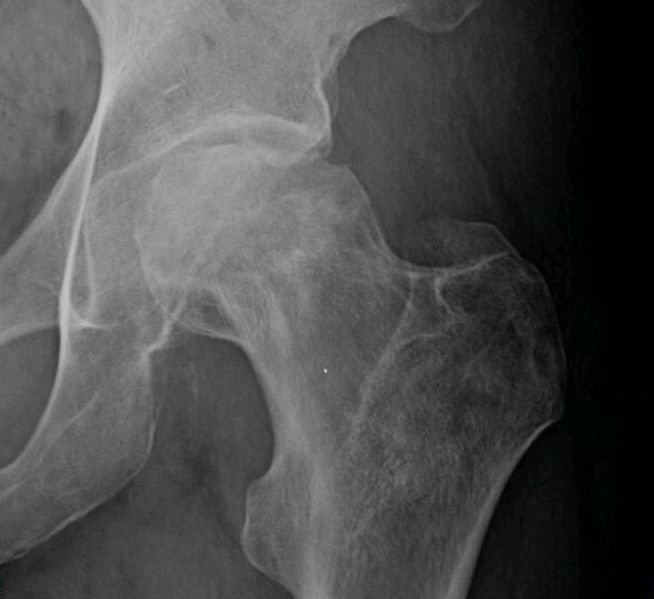Complications with Fractures of the Femur Head
Complications with Fractures of the Femur Head

One of the most common injuries that people might sustain in an auto accident is a femur fracture. The femur is a long bone and fractures can occur anywhere, including at the femur head.
A fractured femur can lead to permanent complications and extensive treatments. If you or a member of your family has suffered a femur fracture in an accident due to another party’s negligence, you could be compensated for your damages. Reach out to our injury lawyers for help with filing a personal injury claim. Call us at (916) 921-6400 for free, friendly advice.
Table of Contents
- Fractures of the Femur Head
- Femoral Head Fractures: Mechanisms of Injury
- How Should Femoral Head Fractures be Treated?
- Complications are Serious
There are many different types of traumatic injuries, including bone fractures, which could develop from an auto accident. One of the most common bone fractures is a femur fracture. The femur has multiple parts, including the shaft and the head. The head of the femur inserts into the acetabulum, or the hip socket, and helps give the leg some mobility.
A fracture of the femur head is a serious issue because there is a significant amount of blood flow that passes through this area. Therefore, a fracture of the femur head could disrupt this blood flow, cutting off tissues from their vital supply of oxygen. For this reason, a significant amount of research has been done regarding fractures of the femoral head. A recent study looked at the mechanisms of injury and complications that could develop from fractures of the femoral head.
Femoral Head Fractures: Mechanisms of InjuryWhen someone suffers extremity trauma, including a fracture of the femur, there are many different mechanisms that should be considered. In the study, over 400 patients with over 400 fractured femurs (some fracturing both femurs) were identified. All of the femur fractures analyzed had femoral head fractures; however, some patients had multiple injuries, called polytrauma. The various mechanisms of injury for these patients were analyzed and close to 85 percent of these patients had been involved in an automobile accident.
This is important because it highlights the point that automobile accidents are a significant risk factor when considering fractures of the head of the femur. When someone is involved in a car accident, they often extend their legs to the front of the vehicle when they slam on the brakes. Some people extend their legs so far that they lock their knees. This straightening of the leg allows the forces from the car accident (particularly if the front of the car is impacted) to travel all the way up the leg into the head of the femur. When all of this force is delivered to the head of the femur, a femoral head fracture can result.
How Should Femoral Head Fractures be Treated?When a patient has suffered a fracture of the femoral head, there are two choices that face the attending physician. The goal of both of these treatments is to immobilize leg, fix the fracture, and repair any hip dislocation that might have developed. Should the fractured fragment simply be removed from the injury site? This would be faster; however, not as precise as a surgical approach. Or, should the patient be taken for a more careful open reduction, requiring surgery and a longer treatment time? The study analyzed the different treatment options and noticed that the efficacy of the results depends on the severity of the fracture.
- Pipkin 1 Fracture: The study noted that for patients with a Pipkin 1 fracture, removal of the fractured fragment yielded better results than a full open reduction with internal fixation. A Pipkin 1 fracture of the femur head is a type of fracture where only a small portion of the femoral head has been broken. Removal of this small fracture, in comparison to a full open reduction, seemed to yield better results.
- Pipkin 2 Fracture: A Pipkin 2 fracture is more serious. This is a full, transverse fracture of the femoral head that separates the cap (or more) from the femoral completely. This requires a full open reduction and internal fixation to repair the break. The study seemed to back these results, demonstrating the patients had better outcomes with a full open reduction and internal fixation.
After patients undergo a surgical procedure to repair this fracture, they must be careful to watch out for the typical complications. Infections developed at a rate of 3 percent and should be handled using the standard treatments of antibiotics and debridement, if necessary; however, there are more severe complications that deserve attention.
The most severe and unique complication that develops from fractures of the femoral head is called avascular necrosis. This occurs when the blood supply to the femoral head has been disrupted. If this blood supply is disrupted, the bone cells in the femoral head stop receiving oxygen and start to die. “Avascular” means without blood and “necrosis” means cell death.
Other potential complications include the development of arthritis in the hip later in life. Overall, the prognosis of patients depends on the type and severity of their fracture and will be handled on an individual basis.
Sacrament Femur Fracture LawyerI’m Ed Smith, a Sacramento Femur Fracture Lawyer. If you have suffered a femur fracture of any type, please contact me at 916.921.6400 or 800.404.5400 for friendly, free advice.
We are members of the National Association of Distinguished Counsel and the Million Dollar Advocates Forum.
See our client reviews on Google, Yelp, and AVVO and case history of verdicts and settlements.
Editor’s Note: This page has been updated for accuracy and relevancy [cha 4.3.20]
Photo by:
:dr ab [CS 1051]